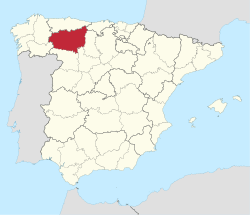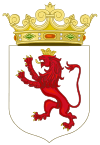Province of León
| León Llión | |||
|---|---|---|---|
| Province | |||
|
The Palacio de los Guzmanes in the city of León, seat of the regional parliament or Diputación | |||
| |||
 Map of Spain with León highlighted | |||
| Coordinates: 42°40′N 6°00′W / 42.667°N 6.000°WCoordinates: 42°40′N 6°00′W / 42.667°N 6.000°W | |||
| Autonomous community | Castilla y León | ||
| Capital | León | ||
| Area | |||
| • Total | 15,581 km2 (6,016 sq mi) | ||
| Area rank | Ranked 7th | ||
| 3.08% of Spain | |||
| Population (2008) | |||
| • Total | 500,200 | ||
| • Rank | Ranked 30th | ||
| • Density | 32/km2 (83/sq mi) | ||
| 1.08% of Spain | |||
| Demonym(s) |
English: Leonese Spanish: Leonés/Leonesa | ||
| Official language(s) | Spanish, Leonese and Galician special protection status | ||
| Parliament | Cortes Generales | ||
| Website | dipuleon.es | ||
León (/leɪˈɒn, -ˈoʊn/; Spanish: León [leˈon]; Galician: León [le'oŋ] ; Leonese: Llión [ʎiˈoŋ]) is a province of northwestern Spain, in the northwestern part of the autonomous community of Castile and León.
About one quarter of its population of 500,200 (2008) lives in the capital, León. The weather is cold and dry during the winter.
There are Roman Catholic cathedrals at León and Astorga. The province shares the Picos de Europa National Park (in the Picos de Europa mountain range) with Cantabria and Asturias. It has 211 municipalities.
History
The province of León was established in 1833 with the new Spanish administrative organisation of regions and provinces to replace former kingdoms. The Leonese Region was composed of the provinces of León, Salamanca and Zamora.
Until 1833, the independently administered Kingdom of León, situated in the northwest region of the Iberian Peninsula, retained the status of a kingdom, although dynastic union had brought it into the Crown of Castile. The Kingdom of León was founded in 910 A.D. when the Christian princes of Asturias along the northern coast of the peninsula shifted their main seat from Oviedo to the city of León. The Atlantic provinces became the Kingdom of Portugal in 1139.
The eastern, inland part of the kingdom was joined dynastically to the Kingdom of Castile first in 1037–1065, again 1077–1109 and 1126–1157, 1230–1296 and from 1301 onward. (See Castile and León#Historic union of the Kingdoms of Castile and León.) León retained the status of a kingdom until 1833, being composed by Adelantamientos Mayores, where Leonese Adelantamiento consisted of the territories between the Picos de Europa and the Duero River.
In 1188 the Kingdom of León developed what may have been the first Parliament in Europe after the Parliament of Iceland. In 1202 its parliament approved economic legislation to regulate trade and guilds.
Language
The Leonese language is recognized by the Statute of Castile and León. The Provincial Government of León signed accords with language associations for promoting Leonese. Leonese is taught in León city, Mansilla de las Mulas, La Bañeza, Valencia de Don Juan or Ponferrada for adult people, and in sixteen schools of León city. The City Council of León writes some of its announcements in Leonese in order to promote the language.
In the western part of the El Bierzo, the westernmost region of the province, Galician language is spoken and taught at schools. It is also officially recognized by the Statute of Castile and León.
Cuisine
Embutidos
- Cecina de León: from beef. In the Leonese language, cecina means "meat that has been salted and dried by means of air, sun or smoke". Cecina de León is made of the hind legs of beef, salted, smoked and air-dried in the province of León, and has PGI status.
- Botillo: from pig. Traditionally made in the western Leonese regions, botiellu in Leonese or botelo in Galician, is a dish of meat-stuffed pork intestine. It is a culinary specialty of the county of El Bierzo and also of the region of Trás-os-Montes in Portugal. This type of embutido is a meat product made from different pieces left over from the butchering of a pig, including the ribs, tail, and bones with a little meat left on them. These are chopped; seasoned with salt, pepper, garlic, and other spices; stuffed in the cecum of the pig; and partly cured via smoking. It can also include the pig's tongue, shoulder blade, jaw, and backbone, but never exceeding 20% of the total volume. It is normally consumed cooked, covered with a sheet. It also has a PGI status.
Cheese
- Queso de Valdeón (Valdeón cheese): a blue cheese produced in Posada de Valdeon, traditionally wrapped in chestnut or sycamore maple leaves before being sent to market.
Wines
- Bierzo: in the west of the Province of León and covers about 3,000 km². The area consists of numerous small valleys in the mountainous part (Alto Bierzo) and of a wide, flat plain (Bajo Bierzo). The Denominación de Origen covers 23 municipalities.
- Tierra de León: in the southeast of the Province of León.
Sweets
- Mantecadas de Astorga
- Hojaldres de Astorga
- Lazos de San Guillermo
- Nicanores de Boñar
Municipalities
Shires (comarcas)
.png)
- El Bierzo
- Maragatería
- Tierra de Campos
- La Montaña
- La Ribera
- La Cabrera
- Tierras de La Bañeza
- Tierras de León
See also
Notes and references
External links
| Wikimedia Commons has media related to Province of León. |
- The Official Tourism Website of the Province of Leon
- Leonese Provincial Government
- Leonese City Council
| ||||||||||||||||||||



